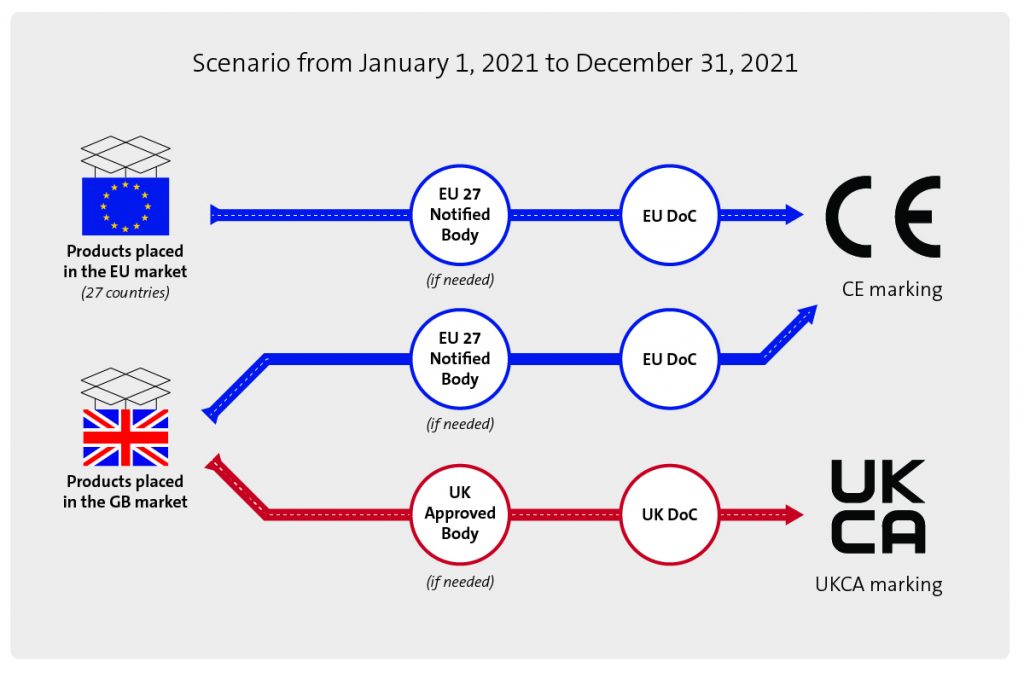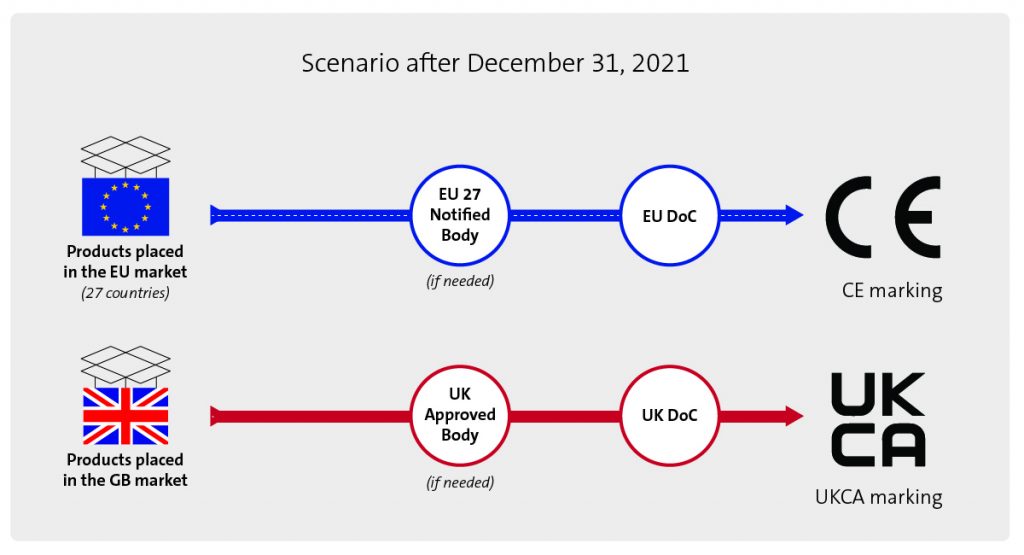As we are all aware, the United Kingdom has now left the European Union. On 24 December 2020, after a prolonged period of negotiations, the UK-EU Trade and Co-operation Agreement was reached between the UK and the EU.


The new deal secures tariff-free access between EU and UK markets, but does not change the compliance process. Product marking and conformity to the UK legislations remains mandatory for placing goods on the market in UK, although this will change from traditional CE marking.
This article from Douglas Masterson, technical manager of the Guild of Architectural Ironmongers (GAI), outlines some of the changes door hardware professionals can expect to see regarding third party conformity assessment marking in Great Britain, Northern Ireland, and the EU. Please note that the information provided is only correct at the time of going to press, as this is an area which is subject to ongoing change.
UKCA marking replaces CE marking
The UKCA (UK Conformity Assessed) marking is a new UK product marking that is used for goods being placed on the market in Great Britain (England, Wales and Scotland). This replaces CE marking which will cease to be used in Great Britain.
UKCA marking is of great importance to the architectural ironmongery industry as any products currently CE marked will require UKCA marking in order to be placed on the GB market. The UKCA marking will not be recognised on the EU market, and it cannot be used for goods placed on the Northern Ireland market, which will require either CE marking or new UKNI marking.
UKCA marking will be optional for products placed on the market in GB (if CE marking is applied instead) until 31st December 2021 but will be mandatory from 1st January 2022. It will need to be used if all the following apply. The product:
- is for the market in Great Britain (England, Scotland, Wales –not Northern Ireland)
- is covered by legislation which requires the UKCA marking.
- requires mandatory third-party conformity assessment.
- if conformity assessment has been carried out by a UK Approved Body (not a EU27 Notified Body)
- is within the scope of a UK designated standard (as opposed to EU harmonised standard)
This does not apply to existing stock, for example if the product was fully manufactured and ready to place on the market before 1 January 2021. In these cases, the product can still be sold in GB with a CE marking if covered by a certificate of conformity issued by a UK body before 1st January 2021.
The following general rules apply in relation to UKCA marking:
- UKCA markings must only be placed on a product by the manufacturer or authorised representative.
- when attaching the UKCA marking, the manufacturer takes full responsibility for the product’s conformity with the requirements of the relevant legislation.
- UKCA marking must only be used to show product conformity with the relevant UK legislation.
- no marking or sign shall be placed that may misconstrue the meaning or form of the UKCA marking to third parties.
- no other markings shall be placed on the product which affects the visibility, legibility or meaning of the UKCA marking.
The UKCA marking cannot be placed on products unless there is a specific requirement to do so in the legislation. It has also been clarified that it can be affixed to a product which bears CE marking, provided that such marking does not create confusion with the CE marking. The UKCA marking as well as any other information concerning UK legislation must be separate from the CE marking and information concerning EU legislation. From 1 January 2023 it must be permanently attached but can be on a label until the end of 2022.
CE marking
CE marking has been hugely relevant to the architectural ironmongery sector as so many of our products fall within the scope of a harmonised European Standard (hEN). These products have therefore required CE marking since the introduction of the European Construction Products Regulation (which has now been replaced in Great Britain by its own version of the CPR). It should be noted, however, that from 1 January 2022, CE marked products will no longer be recognised in Great Britain, unless accompanied by UKCA marking and complying with the relevant UK rules.
Products currently requiring a CE marking will still need this to allow these to be placed on the market in the EU from 1 January 2021.
UK products legitimately CE marked and circulating on the EU28 market prior to 1st January 2021 can continue to circulate until they reach their end user, whether they are in the UK or the EU. However, the EU importer must be able to demonstrate that the product was placed on the EU market prior to this date.
Existing CE certificates issued by UK notified bodies can be used by manufacturers to support UKCA marking (but must be maintained) and are no longer accepted by EU27. Note also that CE marks affixed after the 1st of January 2021 must be supported by an EU27 notified body certificate (where required).
UKNI marking and the Northern Ireland Protocol
The new agreement does not relate to the trade of products between the EU and Northern Ireland, where the Northern Ireland Protocol now applies. This Protocol was designed as a practical solution to avoid a hard border on the island of Ireland, whilst ensuring that the UK, including Northern Ireland, could leave the EU as a whole.
Under the Northern Ireland Protocol, the UK Government has stated that it will ensure that:
- moving goods from Northern Ireland to Great Britain should take place as previously – there will be no additional process, paperwork, or restrictions on Northern Ireland goods moving to Great Britain, therefore providing and delivering unfettered access to GB market.
- changes for goods moving from Great Britain to Northern Ireland will be kept to an absolute minimum – with a new Trader Support Service, available to all traders at no cost to provide extra support.
- trade in goods between Northern Ireland and Republic of Ireland, and between Northern Ireland and EU Member States, will continue unaffected, with no change at the border, no new paperwork, and no tariffs or regulatory checks.
As long as the Protocol is in force, Northern Ireland will continue to align with all relevant EU rules relating to the placing on the market of manufactured goods as it has, in effect remained in the EU’s single market for goods. Therefore, products meet those rules by using the appropriate conformity markings such as CE marking or UKNI marking.
CE marking continues to be used to show that goods meet these EU rules following mandatory third-party conformity assessment by an EU27 Notified Body.
However, if using a UK Approved Body instead, it is necessary to apply for UKNI marking. This is a new conformity marking for products placed on the market in Northern Ireland which have undergone mandatory third-party conformity assessment by a UK approved body or NI Notified Body. It is not possible to use UKNI marking if placing goods on the market in the EU or if planning to use an EU27 Notified body to carry out conformity assessments.
Note that products carrying only UKCA marking only will not be allowed in the Northern Ireland market, these products will also require CE marking or UKNI marking. However, anything manufactured in NI or which is a “qualifying good” from Northern Ireland is allowed access to both EU and GB markets due to “unfettered access” which is stipulated in the Northern Ireland Protocol. Under this these goods can still be CE marked using an EU body for assessment or be UKNI marked and still be accepted in GB marketplace without requiring UKCA marking. (“Qualifying good” is one processed entirely in NI or one that is present in NI and not subject to any customs supervision or control which does not arise from the good being taken out of NI or the EU.)
Definitions
UK Approved Body: As of 1 January 2021, UK Notified Bodies previously operating under the EU Construction Products Regulation and based in the UK no longer have Notified Body status. They have, however been granted new UK ‘Approved Body’ status and are listed on a new UK database on the gov.uk website. Approved bodies will be able to undertake conformity assessment activity for UK designated standards. Where an approved body has undertaken the assessment, the manufacturer (or their authorised representative) must affix the UK marking, either as UKCA or UKNI but not as CE marking.
EU27 Notified Body: This is an organisation designated by an EU country to assess the conformity of certain products before being placed on the market. These bodies carry out tasks related to third party conformity assessment procedures set out in the applicable legislation. Following an appropriate assessment, the notified body will issue relevant certification allowing manufacturers to produce a declaration of performance (DoP), CE mark their products and place them on the market in the EU.
UK Designated Standards: A UK designated standard is a standard, developed by a recognised national or international standards body through a process of consensus, which is designated by Secretary of State and is recognised by UK government in part or in full by publishing its reference on GOV.UK in a formal notice of publication. It is the UK equivalent of an EU Harmonised Standard (hEN).
EU Harmonised Standard: This is a European standard developed by a recognised European Standards Organisation such as CEN or CENELEC. Manufacturers, other economic operators, or conformity assessment bodies can use harmonised standards to demonstrate that products, services, or processes comply with relevant EU legislation. The references of harmonised standards must be published in the Official Journal of the European Union. (OJEU).
Declaration of Performance: This is a key part of the European or UK Construction Products Regulation and provides key information on the performance of a product. Each construction product covered by a UK designated standard, European harmonised standard or for which a European Technical Assessment has been issued needs this Declaration and has to be marked with the appropriate conformity assessment marking such as CE, UKCA or UKNI.
Further detail on this topic is available in Technical Briefing 32F in the members’ section of GAI website.
